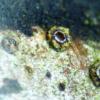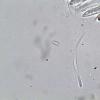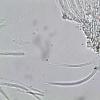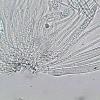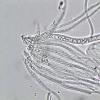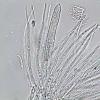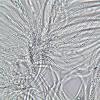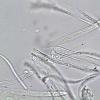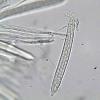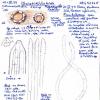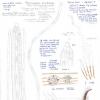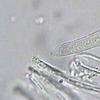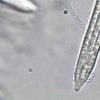
12-11-2025 09:25
 Viktorie Halasu
Viktorie Halasu
Hello, I need help with a pale terrestric Pseudom

11-11-2025 20:16
Bohan JiaHi, lastly I have found these tiny yellow decayin

09-11-2025 13:20
Hello.A tiny ascomycete, appearing as erupting gra

08-11-2025 00:29
 Francois Guay
Francois Guay
I found this species in Quebec, Canada, on herbace
Stictis
Blasco Rafael,
16-11-2015 08:11
 Hola, tengo esta Stictis sobre conos de Pinus, lo mas parecido que veo es Stictis elegans, que les parece?????.
Hola, tengo esta Stictis sobre conos de Pinus, lo mas parecido que veo es Stictis elegans, que les parece?????.sobre las Piñas de Pinus.
Diametro exterior 0,45.
Diametro central 0,26.
Parafisis septadas x2,5--x3, terminando en punta.
Ascas 90--105 x 9--10,
Crozier ¿? J+
Esporas 6 septos, 55--61 x 2,8--3.
Un saludo
Rafael
Hans-Otto Baral,
16-11-2015 09:48

Re : Stictis
Hi Rafael
This is a Naemacyclus, and not surely different from N. fimbriatus which has partly longer spore with 7 septa and a lobed margin, also inamyloid asci.
Could you please show more images in IKI which better show the amyloid apex?
The structure of the margin in section should also be compared, see my drawing.
Do the apos close on drying?
N. fimbriatus occurs on both needles and cones of Pinus.
Zotto
This is a Naemacyclus, and not surely different from N. fimbriatus which has partly longer spore with 7 septa and a lobed margin, also inamyloid asci.
Could you please show more images in IKI which better show the amyloid apex?
The structure of the margin in section should also be compared, see my drawing.
Do the apos close on drying?
N. fimbriatus occurs on both needles and cones of Pinus.
Zotto
Blasco Rafael,
16-11-2015 12:53
Hans-Otto Baral,
16-11-2015 13:09

Re : Stictis
Perhaps ty with KOh pefore.
N. fimbriatus has a plasmatic lens-shaped structure in the apex that may be mistaken as apical ring but is inamyloid and disappears in KOH
N. fimbriatus has a plasmatic lens-shaped structure in the apex that may be mistaken as apical ring but is inamyloid and disappears in KOH

